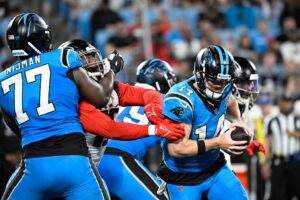Analyzing the NFL 2018 strength of schedule (SOS) is usually done in a pretty straightforward manner. Take the last year’s win-loss record of the opponents, calculate the average and voila. Unfortunately, past win-loss records are bad predictors of what will transpire the following season. What happens if we look for better predictors?
NFL 2018 Strength of Schedule: Is the Win-Loss Record a Broken Record?
Last year’s win-loss record usually does not capture future performance very well. The reasons for this are manifold. First, last year’s records don’t even capture the performance of last year’s team very well. The NFL has a notoriously small sample of games for each team (16 per season). A few outliers here and there can skew results significantly. Close games (i.e. games within one score) can swing on basically one play. Therefore teams consistently tend to hover around .500 in one-score games. Those games are basically proof of teams being at a very similar level of play.
The Outliers: One-Score Game Extremists
Whenever a team gets very good or very bad in one-score games, we have to take their actual win-loss record with a grain of salt. In 2016, there were four teams that went 5+ games over .500 in one-score games: The 12-4 Oakland Raiders, the 10-6 Miami Dolphins, the 11-5 New York Giants and the 13-3 Dallas Cowboys. All four of those teams came down to earth in 2017. They missed the playoffs and won at least four games less than the year before (on average they managed 5.5 wins less than in 2016). There were five teams with five or more games below .500 in one-score games: The 3-13 Jacksonville Jaguars, the 3-13 Chicago Bears the 6-10 Cincinnati Bengals, the 7-9 Philadelphia Eagles, and the 5-11 then-San Diego Chargers. All five of those teams improved in 2017. On average, they won four more games than in 2016.

In 2017, the Carolina Panthers went an incredible 8-1 in one-score games last year, seven games over .500. Their 11-5 record, therefore, is very unlikely to be a true representation of the team’s strength in 2017, let alone in 2018.
The Rest: Better, But Still Iffy
The second main reason to disregard last year’s win-loss record is that even if it were a good representation of last year’s performance, there’s a pretty big turnover each year in the NFL in regards to coaching, roster, schedule etc. Therefore, there is very little stability between one year’s win-loss record with the next year’s. When you look at correlation coefficients between different metrics and next year’s win-loss record, even the best of them have a hard time reaching .40 (which would mean that 40 percent of a team’s record can be explained by that particular metric, the rest comes from factors that are outside of it, such as coaching, roster, turnovers, injuries, schedule, etc.)
Win-loss record notoriously and pretty consistently hovers at .30. This means that 30 percent of next year’s win-loss record can be explained from the previous year’s. From 2000 to 2014 it was exactly .30 and over the last three off-seasons, and it’s at .295. But we have now seen that a few teams that are really lucky in one-score games have a big impact on the records. Maybe those are the “foul apples” and if we remove those, win-loss record suddenly becomes predictable.
Even if we exclude the outlier teams that have at least five wins above or below .500 in one-score games, the previous year’s win-loss loss record correlates with next year’s record at about .38 (Sample: the last three off-seasons, 2014 through 2017). This is an improvement and comes close to what metrics like DVOA can achieve, but it is still a very weak metric to predict next year’s success.
NFL 2018 Strength of Schedule: Better Approaches
As it relates to SOS, even this adjustment doesn’t help us. Very few teams play only teams that are in this nice, more predictable bubble and even if their SOS was somehow closer to the truth, other teams that play for instance Carolina don’t have that same premise, so how do we compare those schedules? How do we adjust for the problem that win-loss record is a bad tool to predict future success in the NFL?
The first adjustment we can make is to take Pythagorean Expectation instead of actual wins and losses. The Pythagorean win expectancy is a metric that measures team quality via point differential. It translates that to a number of wins a team should be expected to win. It captures the flukiness of one-score games since those don’t move the needle much in terms of points differential.
The 538-post mentioned above compares the SOS compiled by the old method of wins and losses with the SOS by Pythagoras. Some teams (Eagles, Brown, Texans for instance) have very similar schedule strengths in both metrics. Their schedule features very few “distorted” teams. But for teams like the Steelers, we get very different results. The Steelers have the 25th-hardest SOS in terms of wins and losses, but the eighth-hardest in terms Pythagorean wins. That’s mainly because the Ravens and Browns are both on their schedule twice, and both were underperforming teams last year.
NFL 2018 Strength of Schedule: DVOA, Simple Rating System
Another metric we can use to calculate SOS is last year’s DVOA rating. Most of the times those agree with win-loss and/or Pythagoras. But for a team like the Atlanta Falcons, it’s noteworthy that they face the fourth-hardest schedule in terms of opposing DVOA rating. Their traditional and even the Pythagorean schedule strength paints it a schedule of middling difficulty.
Pro Football Reference uses a Simple Rating System to measure team strength. Since it works with margin of victory, it too, like Pythagoras, captures well if teams’ records are distorted by one score games. SRS mostly agrees with Pythagoras, but there are deviations. Cleveland, for instance, has the fifth-hardest schedule by wins and losses, the fourth-hardest by Pythagoras, the fifth-hardest by DVOA. But by SRS they face the 15th hardest SOS.
Looking into the Future: Vegas Win Totals
Since all of those metrics so far take 2017 numbers into account, what if we could use some actual projections to calculate the NFL 2018 SOS? Most projections (like the FO Almanac 2018) are not freely available, but there is an exception: Vegas win totals.
The Vegas odds for teams to reach a certain win total are pretty good in incorporating off-season changes, injuries etc. If we use those as a base for calculating SOS, we get some surprising results. For instance, most metrics have the Green Bay Packers with the hardest schedule, based on 2017 numbers. Wins and losses have them with the hardest, Pythagoras with the seventh-hardest, DVOA with the 11th-hardest and SRS with the fifth-hardest.
But none of those metrics capture the fact that Aaron Rodgers is set to return. Vegas bettors do, and hence the win totals for Green Bay’s 2018 opponents are all adjusted accordingly. If a team was projected to win against Brett Hundley, it might now be projected to lose. Since 13 teams face that Rodgers effect, all of those adjustments flow back into the Packers’ SOS. It is 27th according to Vegas.
NFL 2018 Strength of Schedule: Overview
We can summarize all those results in one table:

Basically, we can see how for some teams different metrics vary in terms of their projected SOS. For those teams, we really don’t have a clear picture of what their schedule will look like. Green Bay would be one example, even though their traditional SOS has them ranked number one. Washington and Pittsburgh would be other examples where we have a hard time predicting what the SOS will look like. Their rankings vary so much.
But there are some teams where all metrics have a consistent result. For those teams, we can say with some confidence how their NFL 2018 strength of schedule will look like. The Texans and Raiders, for instance, will have an easy SOS by any measure. All metrics agree that the Saints and the Buccaneers face a tough SOS. Those teams can be analyzed with some confidence since multiple data points back up the SOS.
For most of the others, it means: Take NFL 2018 strength of schedule analysis with a grain of salt. Especially if it uses only one metric. And especially if that one metric is only 2017 win-loss record.






